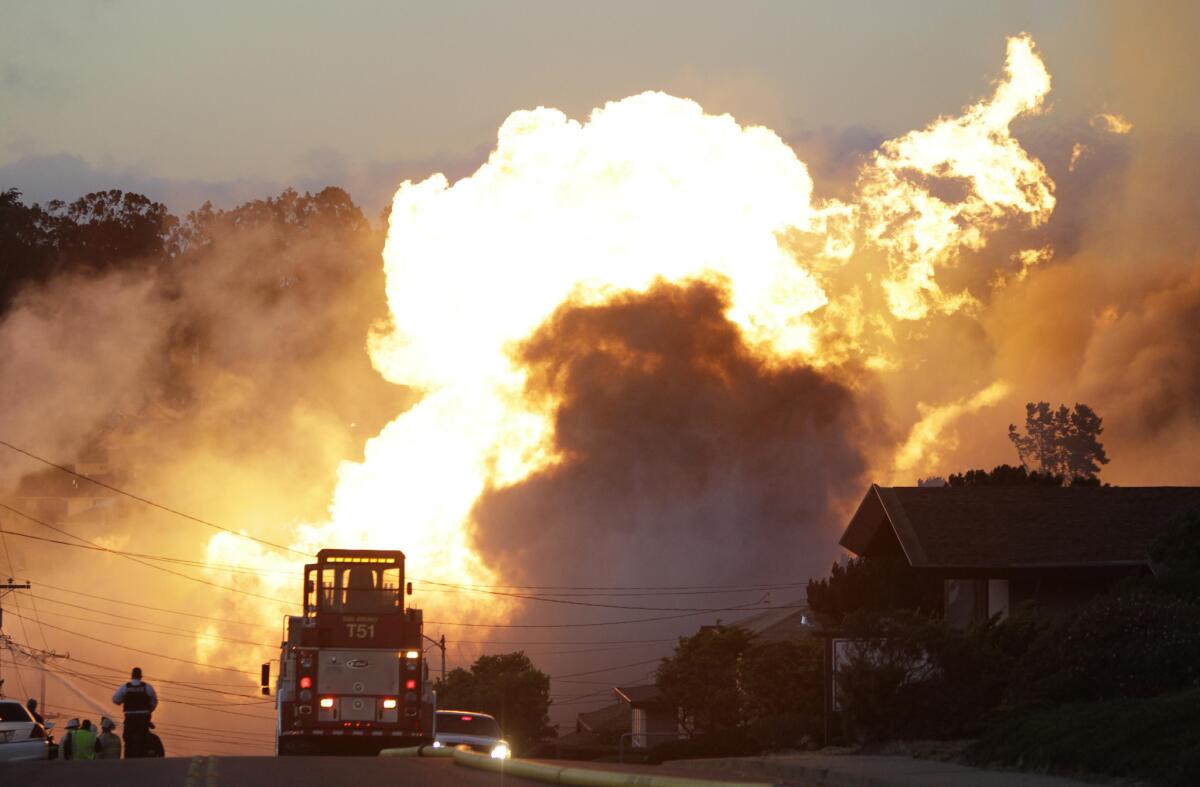PG&E is California’s most troubled electric utility. Time for a government takeover?

- Share via
Time’s up for Pacific Gas & Electric Co. The state’s largest and most troubled electric power provider has failed repeatedly, and disastrously, to deliver power to Northern California safely and reliably. And now we have reached the absurd and horrible point at which the company is either burning down communities (thanks to its downed or malfunctioning power lines) or turning off the power to millions of customers in the (possibly vain) attempt to avoid doing so.
This can’t go on. But there’s little indication that the executives of the delinquent for-profit utility are willing or able to steer the company in a successful new direction. When PG&E emerges from bankruptcy (a situation brought on by the massive liability it incurred when its equipment started wildfires), ideally it will be under new ownership and fundamentally reformed into an accountable and functional electrical provider.
But whose ownership? We’re skeptical that hedge fund managers (who are clamoring for control in the bankruptcy proceedings) or Warren Buffett’s Berkshire Hathaway (which Gov. Gavin Newsom suggested as a possible owner last week) would do a substantially better job of running the utility.
PG&E desperately needs to leave behind the short-term thinking that led it to fail year after year to sufficiently invest in maintaining its gas and electrical infrastructure or to prepare for the entirely predictable stress of climate change on its power lines. And though state regulators have fined PG&E time and again for failing to trim trees or invest in brush management, the lapses continued and so have the fire and pipeline problems. In one particularly shameful example, poorly maintained pipelines ruptured in 2010, leading to an explosion that destroyed 38 homes and killed eight people. PG&E was convicted of six felony counts and fined $3 million for its part in the explosion and is still on probation.
We’ve reached a point where public ownership of PG&E shouldn’t just be on the table, it should be actively explored by state and local officials. Newsom has hinted he would open to public takeover of the utility and has raged about its “corporate greed,” but he has also said he wants to see as many bidders for ownership as possible, including from other profit-making entities. Although it’s good for him to consider all approaches and all bidders, public ownership shouldn’t get short shrift in the process.
There are several different routes to public ownership of a utility. One is for cities to buy out the electrical infrastructure within their borders. “Municipalization,” as it is called, has gained traction in northern California as the public’s simmering anger toward PG&E spiked with its wide-scale pre-emptive power shutoffs this month. Other ideas that have been floated involve breaking the company into regional utilities or, alternately, creating one big public utility district that would subsume PG&E completely. All of the ideas are worth consideration.
Like any major undertaking, there are huge costs involved that would have to be borne by the public, both upfront and on an ongoing basis. But there are big costs for ratepayers either way. They are on the hook for major investments that must be made to increase the system’s resilience to fire no matter who owns it. There will be large sums to pay for fire damages as well. And ratepayer costs would be higher with PG&E because regulators allow the company to make a healthy return on its investments. Publicly owned utilities must put any excess revenues back into the system or into the pockets of ratepayers, not investors.
Of course, merely changing control of PG&E won’t solve the problems caused by decades of neglect. Nor does public ownership automatically translate into trouble-free utilities. Angelenos who are served by city-owned Los Angeles Department of Water and Power can attest to that fact. Public agencies are equally susceptible to bungling basic administrative duties and recklessly deferring maintenance in the face of public pressure to keep rates low. Just as shareholder-owners want more profits, ratepayer-owners want lower bills. The difference with publicly owned utilities is that there is more transparency and accountability when they screw up.
Public takeover is not the right approach for all private utilities. The state’s two other large for-profit power providers, Southern California Edison and San Diego Gas & Electric, have been fairly decent managers of their systems so far. But PG&E’s management has demonstrated that it’s time for a change, and the public option needs to be on the table.
More to Read
A cure for the common opinion
Get thought-provoking perspectives with our weekly newsletter.
You may occasionally receive promotional content from the Los Angeles Times.






